Reading Automobiles
No consumer product compared with the horseless carriage in complexity. There were hundreds of different brand names and types of cars, and even the simplest of vehicles could have thousands of parts. Figuring out what car to buy and how to operate and maintain it required a great deal of information. Learning how to fix it demanded, as one writer put it, "a liberal education in itself."
The motorists' ally in dealing with automotive complexity was the popular press. Specialized publications such as Horseless Age helped car buyers, sellers, owners, operators, repairers, parts suppliers, and even those who just wanted to follow the horseless carriage revolution. More than any invention before or since (except perhaps the computer), the automobile triggered and became part of an "information revolution."
Much debate swirled around what it meant to say a car was "fully equipped". Should
it come with tires, a windshield or top to keep out the rain? And what about headlights
for night operation? Buyers could not take any of these accessories for granted in
horseless carriage days, for the definition of just what standard equipment was
remained in flux. And there was little agreement among federal, state and local laws
as to the equipment required, if, indeed, such laws even existed.
Once owners equipped their machines with the basics, there were always enticing
extras to purchase. From the dawn of the industry, "after market" accessories
allowed people to individualize their machines. Many added clocks, speedometers,
horns, steering wheels, or "Motor-meters," a popular device that monitored engine
water temperature and warned of impending engine overheating.
The mobility the automobile introduced accounted for much of its initial popularity.
Traveling ever-greater distance within a shorter period of time was hailed as
"a revolution in daily life." Touring emerged as a popular new activity. The
drive was an end unto itself as the roads of America beckoned.
Auotmobile societies and clubs were formed, long distance events such as the
Glidden Tours were held, and Transcontinental crossings become major news events.
This trend prompted a new craze in travel. In 1904 alone it was estimated that
several thousand Americans took cross-country automobile vacations. The lure of
the open road was too much to resist and Americans risked much for the adventure
of touring.
The automobile made it possible to view some of the nation's great natural attractions.
Racing was also a way to generate interest in cars and demonstrate their reliability.
In 1908 a group of intrepid racers competed in an around
the world event - New York to Paris via Russia and Western Europe -
that caught the public's fancy. Auto racing today continues to be used as a competetive
weapon in the auto industry.
The early suffragist quickly grasped the advantages of the automobile. Seeking
political clout, yet unable to vote, the women's strategy was to campaign in as many
states as quickly as possible. In 1908, New Yorkers toured the state by trolley, but
this was not going to work in less developed states. The organizers of Illinois'
Equal Suffrage Association in 1910 sent fifteen auto tours throughout their state.
Lawyer Catherine Waugh McCullough noted: "We began to plan for open air meetings
in autos. Our first idea was that with one of our experienced suffragists heading
a tour covering six or seven counties in a week, we might reach most of the State
in the summer of 1910, beginning in June."
In some cases, suffragists had to borrow autos to make their tour, but they found a
wider audience. Lawyer Mary E. Miller wrote that they went to "many places where not
only no suffrage organizations exist, but also no suffrage lecture had ever been
given in town previous to ours."
Their hard work paid off. Illinois granted suffrage in 1913, seven years
before the Nineteenth Amendment was ratified and women's suffrage became national.
In 1899 Mrs. John Howell of Chicago was the first women to obtain a driver's license.
The Los Angeles Times reported in May of 1905 that a Miss. Reedal with two female
friends drove from Los Angeles to Santa Barbara in less than ten hours. Their
gasoline powered car took them over mountainous terrain when roads where barely in
existence.
Mrs. F. J. Linz of San Francisco, whose husband had a car dealership, learned to
drive in early years of last century. She drove passengers on numerous trips between
Carson City and Shaw Hot Springs, Nevada, doing all the auto repair works herself.
Tire punctures had to repaired at a rate of about one an hour because of severely
bad road and excessive heat. In 1906 San Francisco earthquake, she endlessly for
two days carrying women, and children and soldiers to safety. Mrs.Linz organized
the first motor club for women and was president and general manager of the second
San Francisco automobile show in 1908.
Theodore Roosevelt, President of United States from 1901-1909 was often flabbergasted
with the driving escapades of his daughter, Alice. Besides other adventures, Alice
drove along the East Coast with a friend unchaperoned, and drove by herself along
the same route, causing Theodore to lament " I can do one of the two things. I can
be the President of United States, or I can control Alice. I cannot possibly do both."
Although many women are highly regarded in the annals of early women drivers, two
in particular are to be remembered for their courage, skill, and determination.
The first woman to drive across the United States was Alice Huyler Ramsey, a twenty
one-year-old Vassar graduate from New Jersey. It took her 41 days starting from
June 1909 to start from New York to San Francisco. She stated she "was born
mechanical, an inheritance from my father. My husband wasn't mechanical at all."
Even though he supported her cross-country trip and other undertakings, her
husband never learned to drive himself. In 1960, the AAA commended her as the
"Woman Motorist of the Century,"
Joan Newton Cuneo of New York was the best known of the early motor racers. She
purchased her first car in 1902 and after an hour driving lesson, took her two
small children for a ride around Central Park. She entered and won numerous races
in the year between 1905, and 1909, and in 1905, she drove in the first Glidden
Tour, the Grand Prix of the early auto tours. Thirty-three cars entered, and she
was the only woman to participate in this 1,000 mile event. She garnered many
medals for speed and endurance before she stopped racing in 1909 when the American
Automobile Association banned women racecar drivers and women passengers from races
under their sponsorship.
By 1914 many women realized the power and freedom afforded to them by driving an
automobile and envisioned the car as providing a means of employment as well.
Confronting deep-seated cultural beliefs against women working at male-dominated
jobs, early suffragists boldly planned to introduce women as auto-sales women. Two
problems faced them: Not only were the new autos considered too complex for the
women to understand, but usually the husband in the family decided how to spend
discretionary income.
Feminist Crystal Eastman convinced the Maxwell Company to hire auto sales women
on an equal basis with men. A New York Times article on December 16, 1914 praised
the policy, stating ".... that women not only are equal to the task of sharing occupations
with men. But when engaged in them, were worthy of equal pay for equal service."
Two years later, Mrs. Flora B. Barber was lauded as the manager of sixteen agencies on
the West Coast with "several hundred men in her employ." With headquarters in Reno and
Los Angeles, she felt that "women can sell automobile just as well as men. In fact,
I believe that in some instances they sell them better."
Children take readily and enthusiastically to new technologies, often learning about
them faster than their elders. Parents often encourage youngsters by giving them
miniature versions of "grown-up" machines.
Toy cars therefore appeared on the market almost simultaneously with the real ones.
Because Germany dominated the toy industry in this period, American children played
with the imports, such as toy Model T Fords, which were specifically produced for the
American market.
Many youngsters wanted thrills beyond what small toy cars could provide and some of
them found inspiration in articles about building their own play machines. An
article in The Boy Mechanic published in 1914 describes the construction
of an early form of non-powered vehicle, later known as soap-box racer. Racing in
gravity driven cars soon became a part of growing up for many American boys and girls.
The bicycle boom of the 1890's had acquainted thousands of Americans with the joys of
the open road, and many bicycle owners became early buyers of the cars. The country's
size, great distances between destinations, and relative wealth also favored car buying.
From the manufacturer's perspective, in the 1900's it was harder to make a good car
than to sell one. Many carmakers counted on selling their wares at big-city shows,
a custom that also started with the bicycle, because they lacked developed dealer
networks. New York City held the first auto show in the autumn of 1900, and
other cities quickly imitated the practice. Carmakers also advertised heavily,
soon becoming the largest consumer of the services of the newly professionalized
advertising business.
Purchasers faced daunting prospects. Not only were the advertisements misleading,
but each year brought new manufacturers into the market, offering a bewildering
variety of vehicles. There were cars powered by electricity and fuel-based engines;
lightweight buggies with small engines competed with heavy touring machines with
powerful power plants. And buyers got no help from published road tests, owner
surveys, or consumer organizations, for such things hadn't yet been invented.
It was truly the era of caveat emptor, or buyer beware!
The popular song, "You'll Have to Get Out and Get Under," aptly described one
unpleasant aspect of owning a horseless carriage. Before 1910 mechanical breakdowns
were an expected part of motoring. As evidence of this, manufacturers boasted about
the ease with which the crankcases of their cars could be dropped, cylinders removed,
or engines opened up to remove carbon buildup.
Early cars demanded constant attention. "To keep a machine in a state of perfection,
"observed one owner in 1908, "one should devote every morning from ten to forty-five
minutes to carefully oiling and looking over different parts." Even with vigilance,
however, problems occurred. Spark plugs shorted out when the porcelain separated
from the metal; springs were prone to break on encountering bad bumps; and rubber
tires were destroyed by gasoline, sunlight, and sharp stones, which rendered them
truly the Achilles heel of early vehicles.
Early automobile dress was merely an adaptation of contemporary leisure clothing.
After the turn of century, fashion caught up with the motoring phenomenon and new
styles appeared.
Long, loosely fitted coats were worn by both sexes. Designed to allow for maximum
mobility and protection these coats were available in numerous and often
ingenious variations. Leather was the most desired fabric for cool weather
while the lighter weight "duster" in linen or cotton was favored for summer driving.
Automobile accessories were critical features for motoring dress. From gloves
to goggles; caps to hoods; protection and fashion were both critical elements
of open air driving. Automobile and fashion periodicals lavishly illustrated
the very latest in accessories which flooded the American and European markets,
ensuring that the auto enthusiast kept apace with the latest developments in
fashion as well as in technology.
Ford's Model T introduced the automobile to a wider American buying public. With the
introduction of this hugely successful car, opposition to the automobile, already in
decline, virtually vanished .
Clean, comfortable, and easy to operate, electric cars didn't need cranked or motor driven
starters and many were designed as enclosed vehicles. Electric cars had limited
range (improving from 20 to 50-100 miles per charge by 1910) and were less powerful than
gasoline powered cars, making them best suited for running errands about town.
Manufacturers predicted in 1899 that "...the whole of the United States
will be...sprinkled with electric charging stations."
Perhaps the most popular electric car sold in the United States was the Detroit Electric,
which began production in 1907. Originally produced by the Anderson Carriage Company,
the company changed its name to Detroit Electric Car Co. in 1918 and continued to build
electric vehicles until ceasing operations in 1939. The best production year was 1916,
with about 3,000 units sold.
Ultimately, the limitations of electric cars outweighed their good points.
Although Thomas Edison optimistically announced a long-distance electric storage
battery in 1901, he was unable to effectively manufacture it until 1908.
The 1908 battery provided a range of up to 200 miles, but was expensive (over $600)
and inefficient when charging (over 30% of the charging energy was wasted).
After World War I started, manufacturing capacity was diverted to batteries for submarines
until 1920.
As a result, as long distance touring and high speed driving became popular in America,
neither could be done in an electric car. The gasoline-powered engine won out,
but good ideas are persistant: as we begin the twenty first century, we are thinking
again about the advantages of the electric car.
In 1901, however, poor quality control prompted three new buyers to demand their
money back. The sheriff helped them to get it. The owner of the rights to
manufacture the De Dion then offered to sell them to anyone "who may wish to
take them up." No one did, and the firm became one of the five thousand or so
fatalities of a volatile, everchanging industry.
Packards quickly became leaders in the highly priced field, offering such
innovations as the automatic spark advance and familiar "H" pattern for shifting
gears. The company also was a pioneer in builing lavish structures to house
their dealers. These facilities, located in most larger cities, stocked
large inventories of parts and contained machine shops, showrooms, and
customer waiting rooms.
The company entered three cars in the New York City to Buffalo race of 1901.
The car boasted 12 horsepower and a top speed of 25 miles per hour. An optional
third gear enabled one to get "up to 30 miles per hour ...if desired."
Franklin priced his cars for the middle and upper end of the market: They were
considered luxury cars. Despite Franklin's innovative
designs and impressive performance, increasing competition from Packard and Cadillac,
plus the effects of the Depression, eventually drove the company under.
Leland became involved with Cadillac through a series of business calamities.
In 1901 his Detroit machine shop contracted to produce some engines for what
would be the first mass produced automobile, the curved-dash olds. But the
Olds Motor Works rejected Leland's design. Although the motors produced more
horsepower than the company's own engine, it would have required expensive
retooling to mass produce the new design. A year later Leland showed the
rejected engine to some disgruntled backers of Henry Ford, and together they
teamed up to start a new firm.
Thus was born the Cadillac Automobile Company, named for Le Sieur Antoine
de la Mothe Cadillac, the French explorer who had discovered Detroit in the
early eighteenth century.
Its slogan was "The Car Complete"
500 were produced in 1909.
Prognostication of the fate, acceptability and influence of automotive transportation
was prolific and heard from a wide range of sources:
"The speedy extinction of the horse is popularly anticipated. I do not take this view.
He may be relegated to comparative obscurity, and possibly, in course of time to
the zoo; but it is not we who shall live to see his extinction."
W.W. Townsend in Motor Age, 1901.
"Nor did the car give me much trouble. A broken bolt coming over the mountains,
two connecting rod breakages and an axle nut dropping off and letting the balls
out--this was the sum total."
Dr. Jackson in Motor World, 1903
"Three of your 45 horsepower Columbias have been used by myself and assistants,
Shaugnessy and Wills, continuously night and day since the earthquake April 18,
and are still in service. Their work has been perfect at all times and I marvel
that my automobile can stand up to such an unusual and severe test. I was
skeptical about the automobile previous to the disaster, but now give it
my hearty endorsement."
John Dogherty, Acting Chief, SF Fire Department, in telegram to
Electric Vehicle Company, 1906
"The novelty of owning an automobile has largely worn off. The neighbors have one
of their own. The whole family has become so accustomed to auto riding that some
members generally prefer to ride alone or remain behind while others go."
Charles Duryea, in the Independent, 1909
"There are more than 200 persons in New York who have from five to ten cars
apiece. John Jacob Astor alone is credited with thirty-two."
Henry Jay Case in Harper's Weekly, 1906
"Many of the newspapers circulating chiefly among the working class [which]
try to make capital out of class hatred and lose no opportunity to hold up the
automobile as a means of oppression of the poor by the wealthy."
Horseless Age, 1902
"The automobile has no more consistent and more loyal set of users than
the medical fraternity. First and foremost, the doctor invests in an automobile
for business use; it will take where he wants to go-where he is needed ,often
very urgently- in a fraction of the time any other method of transportation at
his command can possibly do."
Automobile, 1908
"Of course the wealthy classes are still our chief customers. But they are no
longer the exclusive buyers, even of moderately expensive cars, as was the case
a year ago. The bank clerk and similar young men with plenty of time and earning
good salaries are now found among our customers."
Gearge A. Banker, auto dealer, in Motor World, 1903
"Nothing has spread socialistic feeling more than the use of the automobile...
a picture of the arrogance of wealth.'
Woodrow Wilson, President, Princeton University, 1906
"The physician whose business requires him to keep two or three horses certainly
will find a well made automobile a good investment; not only because it cuts out the
expense of the horses, but in the saving of time lion calls] to devote to the office,
and no physician can estimate what this is worth to him in this age of sharp competition."
Dr. C.A. Shepard, in Horseless Age, 1903
"According to my experience and that of my friends it is impossible to maintain
an automobile as cheaply as horses, though mile for mile, considering the great
distances that an automobile will travel, it is cheaper.
Harry B. Haines, in World's Work, 1906
"It is in the running of a car, the handling of it, and its obedience to one's
will, that the keenest enjoyment of automobiling is found.
Frank A. Munsey, in Munsey's Magazine,1906
"[The automobile] develops a sense of community in agricultural districts which was
utterly impossible with the former methods of transportation. It makes the farmer's
life and surroundings much more liberal, and, under many conditions, far more
attractive even to the young people than the life of the city."
Hayden Eames, General Manager,Studebaker, 1909
"Kind wife--John, dear, what are you weeping about? Husband--I--I just looked
through this auto supplies catalogue and find there 2,500 accessories our car
hasn't got."
Automobile Jokes, Jests and Joshes, 1913
The horsepower of an automobile may sometimes be judged by the number of horses
required to haul it to the repair shop."
Automobile Jokes, Jests and Joshes, 1913
If the automobile was not universally appreciated at its inception, attitudes were
rapidly changing in the early part of the 20th century, as seen in the quotes below:
"...that the automobile played an all but indispensable part in saving the western
part of San Francisco, and at the same time has proved invaluable in the serious
business of governing the city through it greatest stress, is conceded by every
man who has had his eyes open during the ten days or so that have elapsed since
the earthquake. Old men in the bread lines who had previously occupied much of
their time in supper-table denunciation of the whizz-wagons now have nothing but
praise for them. Men high in official service go even further and say that "but
for the auto, it would not have been possible to save even a portion of the city or
to take care of the sick or to preserve a semblance of law and order."
San Francisco Chronicle, 3 May 1906
"The automobile is the idol of the modern age...The man who owns a motorcar gets
for himself, besides the Joys of Touring, the adulation of the walking crowd, and
the daring driver of a racing machine that bounds and rushes and disappears in the
perspective in a thunder of explosions is a god to the women."
George Dupuy, The Conquering Automobile', April 1906
"Many of the newspapers circulating chiefly among the working class try to make
capital out of class hatred and lose no opportunity to hold up the automobile as
a means of oppression of the poor by the wealthy"
Horseless Age, September 1902
"The [wealthy classes] are no longer the exclusive buyers, even of moderately
expensive cars, as was the case a year ago. The bank clerk and similar young
men of with plenty of time and earning good salaries are now found among our customers"
George A. Banker 1903 (eastern auto dealer)
"We farmers are not opposed to the motorcar...it will be an important feature in
making farm life more attractive. When the motorcar becomes cheaper in price through
more general use, the farmer will be the first to adopt it for business and pleasure."
G.W.F. Gaunt, New Jersey State Grange Master, 1906
"The automobile has no more consistent and more loyal set of users than the medical
fraternity. First and foremost, the doctor invests in an automobile for business
use; it will take him where he wants to go- where he is needed, often very
urgently - in a fraction of the time any other method of transportation at his
command can possibly do - - it is scarcely to be wondered at that doctors comprise
a very large portion of the total number of auto users."
Automobile May 1908
Bibliography
Web Sites
Antique Automobile Club of America A history of
the automobile
The Automobile in American Life and Society A University of Michigan study
Credits
Private communication from Galen Handy, Detroit Electric Car Co., 2006
Photos: Jenny Wright, AACA (1896 Duryea). Other photos from the exhbit by MOAH staff.
Equipping The Car
Touring
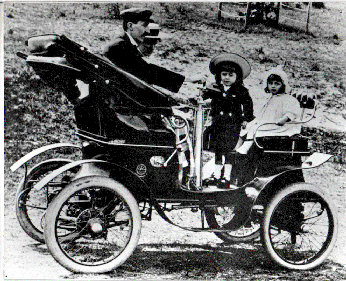 Short distance touring was an added feature of the new trend in touring. The traditional
Sunday outing could now encompass even greater distance. Many argued that a leisurely
drive in the county offered modern urban Americans a superior form of relaxation,
entertainment and family unity.
Short distance touring was an added feature of the new trend in touring. The traditional
Sunday outing could now encompass even greater distance. Many argued that a leisurely
drive in the county offered modern urban Americans a superior form of relaxation,
entertainment and family unity.
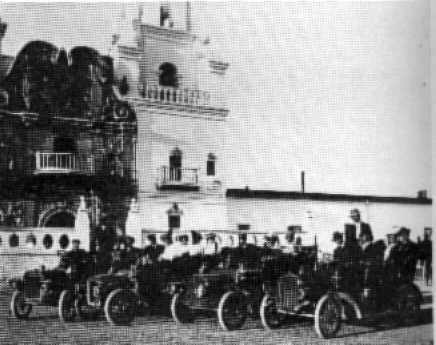 Group motor tours combined socializing and sightseeing. Formerly remote places of
historical interest were now accessible. Here a group of enthusiasts
visit the rural San Xavier Mission in Arizona.
Group motor tours combined socializing and sightseeing. Formerly remote places of
historical interest were now accessible. Here a group of enthusiasts
visit the rural San Xavier Mission in Arizona.
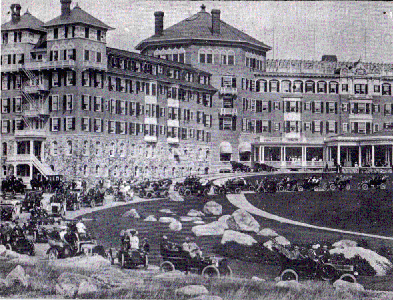 Between 1905 and 1913 the Glidden reliability tours were run. Sponsored by
Charles J. Glidden, a millionaire automobile enthusiast, the tours were intended to
demonstrate the reliability of the various motorcars on the market. The first Glidden
tour in July 1905 took eleven days and covered an 870 mile route through New York City
and New England. As one participant noted: "The tour has proved that the automobile
is now almost foolproof. It has proved that American cars are durable and efficient.
It has shown the few who took part how delightful their short vacation may be, and
it has strengthened our belief in the permanence of the motorcar. By 1907 popular
interest in reliability runs was giving way to interest in gasoline economy runs.
Between 1905 and 1913 the Glidden reliability tours were run. Sponsored by
Charles J. Glidden, a millionaire automobile enthusiast, the tours were intended to
demonstrate the reliability of the various motorcars on the market. The first Glidden
tour in July 1905 took eleven days and covered an 870 mile route through New York City
and New England. As one participant noted: "The tour has proved that the automobile
is now almost foolproof. It has proved that American cars are durable and efficient.
It has shown the few who took part how delightful their short vacation may be, and
it has strengthened our belief in the permanence of the motorcar. By 1907 popular
interest in reliability runs was giving way to interest in gasoline economy runs.
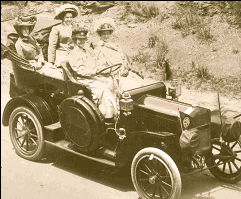 The first woman to drive across the United States was Alice Huyler Ramsey. At
twenty-one this Vassar graduate from New Jersey and her crew took 41 days to travel
from New York to San Francisco in June of 1909. She later stated that she "was born
mechanical, and inheritance from my father. My husband wasn't mechanical at all.
Even though he supported her cross-county trip and other undertakings, her husband
never learned to drive himself. In 1960 the AAA commended her as "Woman motorist
of the Century'.
The first woman to drive across the United States was Alice Huyler Ramsey. At
twenty-one this Vassar graduate from New Jersey and her crew took 41 days to travel
from New York to San Francisco in June of 1909. She later stated that she "was born
mechanical, and inheritance from my father. My husband wasn't mechanical at all.
Even though he supported her cross-county trip and other undertakings, her husband
never learned to drive himself. In 1960 the AAA commended her as "Woman motorist
of the Century'.
Women and the Auto
Suffragists
Women Drivers
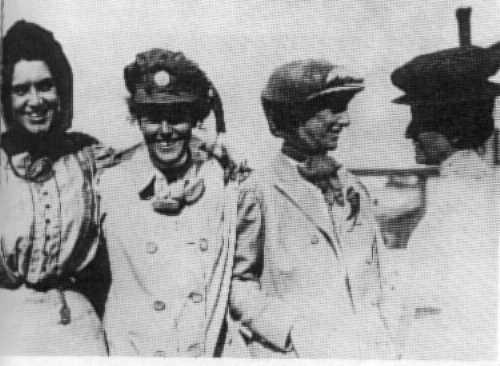 Victorian ideas of what constituted masculine and feminine behavior prevailed in
early decades of this century, resulting in a bias against women drivers. Their
biological makeup was thought make women foolhardy, impulsive, timid, and mechanically
disinclined. Similar reasons were used to explain why women did not receive a
higher education or the vote. In spite of this, many women refused to conform
to traditional expectations, and did learn to master the machine.
Victorian ideas of what constituted masculine and feminine behavior prevailed in
early decades of this century, resulting in a bias against women drivers. Their
biological makeup was thought make women foolhardy, impulsive, timid, and mechanically
disinclined. Similar reasons were used to explain why women did not receive a
higher education or the vote. In spite of this, many women refused to conform
to traditional expectations, and did learn to master the machine.
Early Automotive Pioneer Women
Women's Entry into Auto Sales
Playing with cars
Selling Automobiles
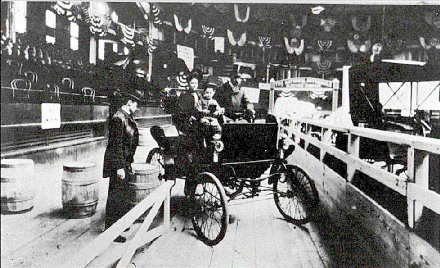
Maintaining and Repairing Automobiles
Dressing the Part
Resisting the Automobile
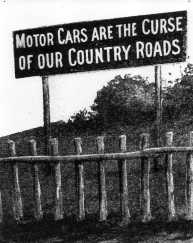 Much of the rural opposition to automobiles was waged chiefly at touring motorists.
Farmers claimed tourists posed a danger to stock, horsedrawn traffic and even crops.
Opposition to automobiles ranged from plowing up roads, barbed wiring roads making
them impassable to boycotting car-driving businessmen who attempted to conduct
business with farmers and even refusing to support politicians who owned automobiles.
Much of the rural opposition to automobiles was waged chiefly at touring motorists.
Farmers claimed tourists posed a danger to stock, horsedrawn traffic and even crops.
Opposition to automobiles ranged from plowing up roads, barbed wiring roads making
them impassable to boycotting car-driving businessmen who attempted to conduct
business with farmers and even refusing to support politicians who owned automobiles.
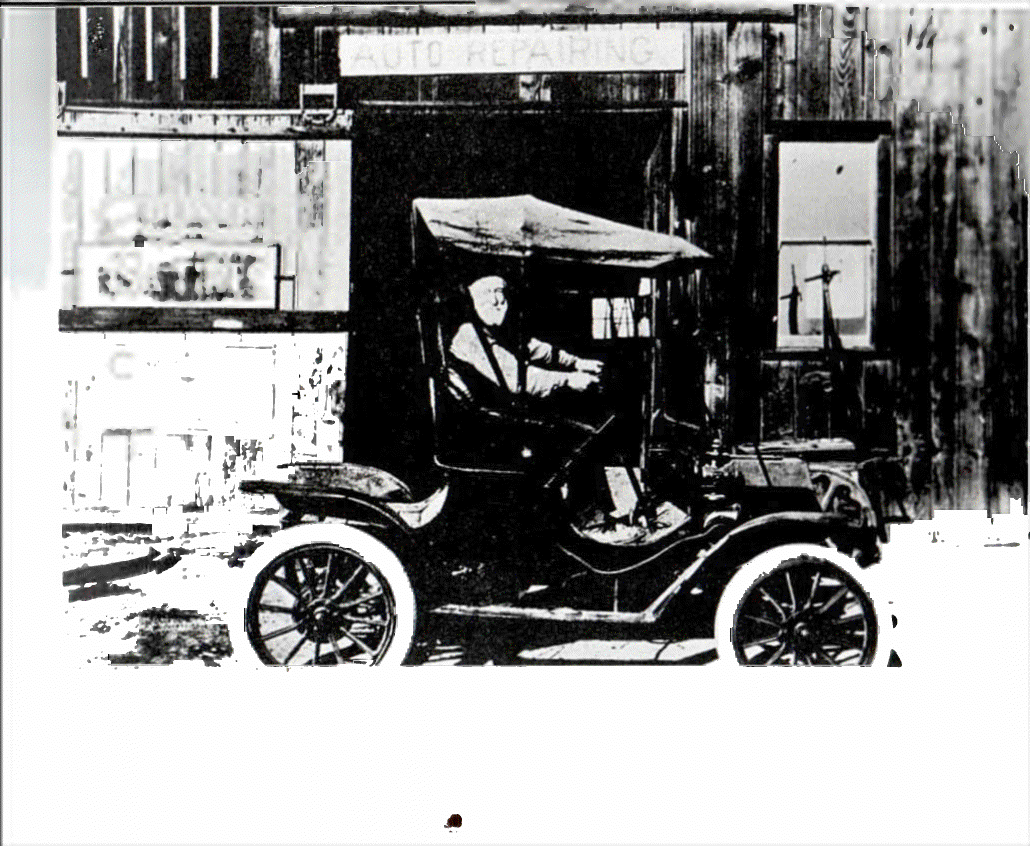 While most horsebreeders were put out of business by the horseless carriage,
blacksmiths, carriage makers, and livery stable operators might adapt their operations
to accommodate the new machines. This blacksmith converted his shop to an early service
station of horseless carriages. Reconciliation began when the unparalleled service
the automobile provided during the San Francisco earthquake of 1906 served
to entrench its usefulness and relative reliability in the mind of American society.
200 privately owned motorcars, a caravan of motortrucks led by Walter C. White,
and 15,000 gallons of gasoline donated by Standard Oil were all part of the
relief effort in post-quake San Francisco.
While most horsebreeders were put out of business by the horseless carriage,
blacksmiths, carriage makers, and livery stable operators might adapt their operations
to accommodate the new machines. This blacksmith converted his shop to an early service
station of horseless carriages. Reconciliation began when the unparalleled service
the automobile provided during the San Francisco earthquake of 1906 served
to entrench its usefulness and relative reliability in the mind of American society.
200 privately owned motorcars, a caravan of motortrucks led by Walter C. White,
and 15,000 gallons of gasoline donated by Standard Oil were all part of the
relief effort in post-quake San Francisco.
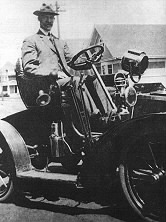 Physicans were one of the first professions to widely adopt the automobile. The more
reliable and faster auto ensured that housecalls, particularly to rural patients
could be easily undertaken. For example, Dr. Thomas Williams (shown at right), who
was the first pysician in Palo Alto to own an automobile, drove a 1906 Autocar.
Physicans were one of the first professions to widely adopt the automobile. The more
reliable and faster auto ensured that housecalls, particularly to rural patients
could be easily undertaken. For example, Dr. Thomas Williams (shown at right), who
was the first pysician in Palo Alto to own an automobile, drove a 1906 Autocar.
The Electric Car
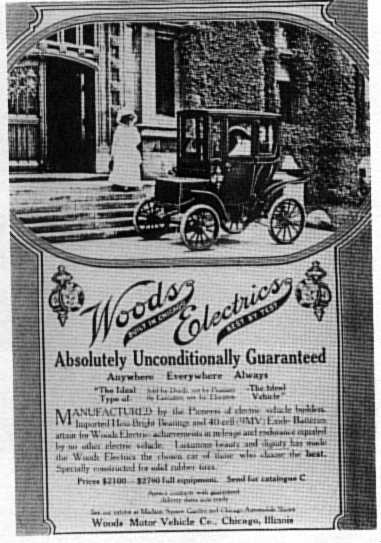 As we face a myriad of environmental problems caused by driving gasoline-fueled cars
for nearly a century, an innovative and viable solution for the problem may be the
electric car. A battery operated electric car, noiseless, odorless, pollution-free,
could be the answers to worries about toxic fumes and depletion about natural
resources. Intriguing, though, is that thousands of electric cars were in
operation for twenty to thirty years around the turn of twentieth century and that
women drove most of them. In fact, the cars were marketed heavily to women, as shown
by the ad illustrated here, once sales analysis indicated women were the primary
market for the electric car.
As we face a myriad of environmental problems caused by driving gasoline-fueled cars
for nearly a century, an innovative and viable solution for the problem may be the
electric car. A battery operated electric car, noiseless, odorless, pollution-free,
could be the answers to worries about toxic fumes and depletion about natural
resources. Intriguing, though, is that thousands of electric cars were in
operation for twenty to thirty years around the turn of twentieth century and that
women drove most of them. In fact, the cars were marketed heavily to women, as shown
by the ad illustrated here, once sales analysis indicated women were the primary
market for the electric car.
Exhibit Companion
De Dion -- 1899
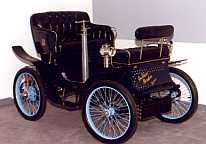 This car was originally designed and
manufactured in France. An American firm, De Dion-Bouton Motorette Company, then
procured a license and in 1990-1901 produced the car in Brooklyn, New York. In a
somewhat non-commital tone, Motor Age reported that the company's many selling
points was "That its manufacturing operations are along lines which have been
given a thorough test on the other side of the Atlantic."
This car was originally designed and
manufactured in France. An American firm, De Dion-Bouton Motorette Company, then
procured a license and in 1990-1901 produced the car in Brooklyn, New York. In a
somewhat non-commital tone, Motor Age reported that the company's many selling
points was "That its manufacturing operations are along lines which have been
given a thorough test on the other side of the Atlantic."
Packard -- 1901
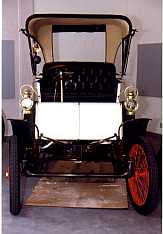 " Make a better one if you can!" These
words from automaker Alexander Winton in 1899 inspired James Ward Packard to go
into automobile manufacturing. Packard had purchased a Winton, been disappointed with its
performance, and complained to the manufacturer.
" Make a better one if you can!" These
words from automaker Alexander Winton in 1899 inspired James Ward Packard to go
into automobile manufacturing. Packard had purchased a Winton, been disappointed with its
performance, and complained to the manufacturer.
Knox -- 1904
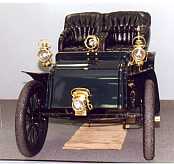 If one looks at the engine beneath the Knox, one will see dozens of metal pins
sticking out of the motor's cylinders. These pins conduct heat from the cylinder
outward, so that when car moves forward, the air stream cools the engine. This
unusal configuration prompted owners affectionately to nickname the Knox "Old Porcupine."
And air cooling saved the weight and hassle of water cooling.
In 1895, Harry A. Knox worked for the Overman Wheel Company of Chicopee Falls, where
he built three experimental gasoline cars. Three years later, he left in a huff
when the owner decided he wanted to manufacture a steam car. Then in 1900 Knox
formed the Knox Automobile Comapny, building three wheeler runabouts. The
air-cooled 1904 model was known as "The Car that Never Drinks."
If one looks at the engine beneath the Knox, one will see dozens of metal pins
sticking out of the motor's cylinders. These pins conduct heat from the cylinder
outward, so that when car moves forward, the air stream cools the engine. This
unusal configuration prompted owners affectionately to nickname the Knox "Old Porcupine."
And air cooling saved the weight and hassle of water cooling.
In 1895, Harry A. Knox worked for the Overman Wheel Company of Chicopee Falls, where
he built three experimental gasoline cars. Three years later, he left in a huff
when the owner decided he wanted to manufacture a steam car. Then in 1900 Knox
formed the Knox Automobile Comapny, building three wheeler runabouts. The
air-cooled 1904 model was known as "The Car that Never Drinks."
Franklin -- 1904
 From 1902 to 1934, the Franklin Automobile Company (named after Entrpreneur and
founder Herbert Franklin) built cars with powerful air-cooled engines. The 1904 model shown
here is similar to the Franklin vehicle that won a 1904 transcontinental race.
From 1902 to 1934, the Franklin Automobile Company (named after Entrpreneur and
founder Herbert Franklin) built cars with powerful air-cooled engines. The 1904 model shown
here is similar to the Franklin vehicle that won a 1904 transcontinental race.
Cadillac -- 1905
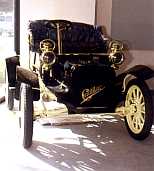 Cadillac's precise machining pioneered the concept of interchangeable parts
(new to the automobile industry). The genius behind that precision was Henry Leland,
a talented Detroit machinist who had learned his trade in the New England arms industry.
Cadillac's precise machining pioneered the concept of interchangeable parts
(new to the automobile industry). The genius behind that precision was Henry Leland,
a talented Detroit machinist who had learned his trade in the New England arms industry.
Firestone Columbus -- 1909
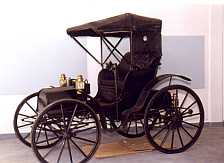 Named for the Columbus Buggy president, Clinton Dewitt Firestone. The company
refused to follow the style of other carmakers that made major styling changes
on a yearly a basis. Columbus department heads would meet daily at 9.00 a.m. to
suggest improvements. Those passed would be immediately brought into production.
That this policy may not have been proven successful is indicated by the fact
that Columbus Buggy went broke in 1913.
Named for the Columbus Buggy president, Clinton Dewitt Firestone. The company
refused to follow the style of other carmakers that made major styling changes
on a yearly a basis. Columbus department heads would meet daily at 9.00 a.m. to
suggest improvements. Those passed would be immediately brought into production.
That this policy may not have been proven successful is indicated by the fact
that Columbus Buggy went broke in 1913.
Quotations
On Resisting the Automobile

This page last updated: September 26, 2006
Copyright © Museum of American Heritage

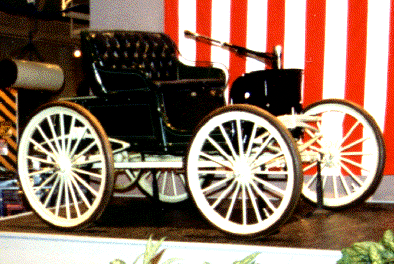 As early as 1896, J. Frank and Charles Duryea established the Duryea Motor Company in
Peoria, Illinois, and sold the first dozen American-made cars.
By 1900 American carmakers had sold about 8,000 vehicles, and by 1910, registrations had soared
nearly to half million and were rising rapidly. Leading the adoption of automobiles
were doctors and other professionals, but others quickly followed, putting cars into
service for the purpose of business, politics, commuting, and recreation. By
1910 automobiles were already becoming necessities.
As early as 1896, J. Frank and Charles Duryea established the Duryea Motor Company in
Peoria, Illinois, and sold the first dozen American-made cars.
By 1900 American carmakers had sold about 8,000 vehicles, and by 1910, registrations had soared
nearly to half million and were rising rapidly. Leading the adoption of automobiles
were doctors and other professionals, but others quickly followed, putting cars into
service for the purpose of business, politics, commuting, and recreation. By
1910 automobiles were already becoming necessities.